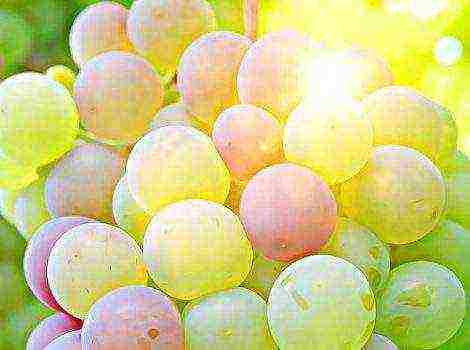Content
- 1 The best dark red beets without light rings
- 2 Varieties for the Moscow region
- 3 Varieties for the Urals
- 4 Varieties for Siberia
- 5 Early maturing varieties
- 6 Mid-season varieties
- 7 Late-ripening varieties
- 8 How to grow delicious beets?
- 9 Bordeaux 237
- 10 Bravo
- 11 Valenta
- 12 Mona
- 13 Mulatto
- 14 Incomparable А463
- 15 Pablo F1
- 16 Rocket F1
- 17 Cylinder
Beetroot is one of the most famous vegetables and has been known for a long time. To get a good harvest of these root crops suitable for winter storage, you need to choose the right varieties. There are quite a few varieties of beets, and when choosing, you need to take into account that they are divided according to ripening times, adaptability to a particular climate, soil and other characteristics of the culture.
Only the best beets can be used to make delicious salads, soups, borscht, snacks, vinaigrettes and pickles.
Beets are divided into 3 groups according to the ripening period, these are: early, middle, late.
The best dark red beets without light rings
Early varieties
Early varieties of beets allow you to feast on a variety of dishes from this delicious vegetable in the summer, immediately after harvesting the fruit. The vegetable can be consumed without heat treatment. Sowing of seeds in such varieties occurs earlier than others, and harvesting occurs in 75-110 days.
Bordeaux 237
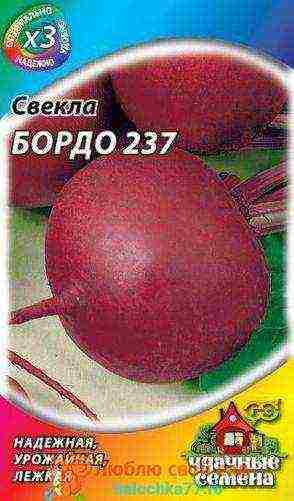 Bordeaux 237
Bordeaux 237
It belongs to one of the most famous cold-resistant beet varieties. Ripening of this variety occurs in 99-120 days. Fruits are medium in size, round in shape. The taste is pleasant, sweet, characteristic of this vegetable. The pulp is dark red. When frozen, taste is not lost. Beets with a long shelf life (more than six months). Suitable for sowing before winter. Not susceptible to damage by pests, diseases.
Modana
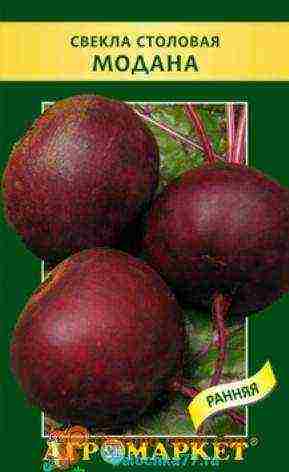 Modana variety
Modana variety
Modana red beet has a neat and beautiful round shape. A variety without light rings. The color of the variety is dark, burgundy-cherry. Weight reaches 130-260 grams. The pulp is pleasant to the taste, sweetish. Grown with seedlings. From the moment of planting young plants to harvest, 68-85 days pass. The variety is cold-resistant, unpretentious, disease-resistant. Suitable for bundling and recycling. It is not stored for long.
Pablo F1
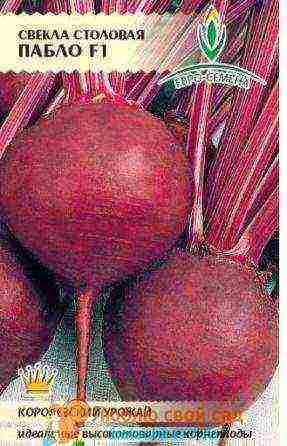 Pablo variety
Pablo variety
Early ripe, sweet variety. The fruits are round in shape. The size is the same. Weight 195-380 grams. The skin is thin. Root crop without light rings. The pulp is rich in color, dark red. Fruit collection is uneven, starting from 85-95 days. The variety is stable, it can be stored for several months. Dark varieties of beets are ideal for making vinaigrette.
Bohemia
Bohemian variety
Refers to dark varieties of beets. The shape is round. The color is even, dark burgundy. A variety without light rings. The taste is sweet, delicate and very juicy. Root crops ripen in 77-83 days. Beets of this variety are resistant to diseases and are well stored. Does not lose its appearance, taste during storage.
Detroit
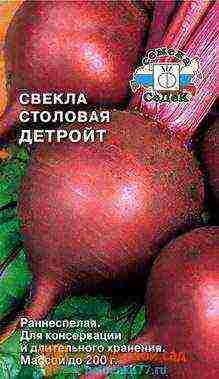 Detroit variety
Detroit variety
Cold-resistant, early ripening variety. It does not freeze during spring frosts. The plant, during active growth, is demanding for watering. Red beets without light rings. The fruits are small and small. Weight reaches 210 grams.
The shape is neat and round. The harvest is massive, begins on the 105-110 day. The variety is not susceptible to disease. When feeding, the size of the fruit increases.
Boltardi
 Boltardi variety
Boltardi variety
An early, high-yielding, cold-resistant variety. Root crops are frost-resistant. The pulp is juicy, tasty, dark red in color.Radial rings are visible on the cut. Average weight 160 grams. Fruits are smooth, neat, rounded.
The variety is well stored, not afraid of frost, resistant to most diseases. When sowing under cover in spring, it is suitable for bunch harvesting. With late sowing, the harvested crop can be stored for the winter for 3-5 months.
Egyptian flat
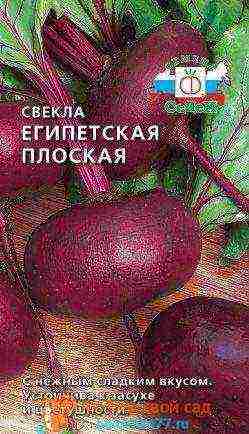 Grade Egyptian flat
Grade Egyptian flat
It is famous for its large (more than 500 grams) fruits. The pulp is purple-burgundy. Small radial circles are visible. The taste is sweet, juicy, ideal for vinaigrette. Ripening in the Egyptian flat variety occurs in 90-100 days. The variety is drought-resistant, stored for more than six months.
Mona variety
 Mona variety
Mona variety
One-sprout, grown from seedlings. Cylindrical beets. Weight reaches 300 grams. Harvesting is done in 105-115 days. Beets of this variety are suitable for bundling and processing.
Medium varieties
These varieties easily tolerate sowing for the winter. Summer drought does not harm fruit formation. Shelf life is longer than that of earlier varieties. Mid-season varieties are divided into several types and when choosing seeds, all the characteristics of the variety must be taken into account.
Borsch
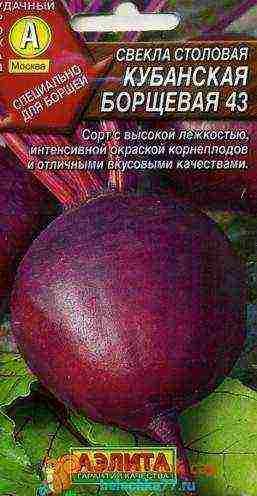 Variety Borshchivaya
Variety Borshchivaya
Borscht beet is suitable for growing on any soil. The pulp is pleasant to the taste, soft, dark raspberry color. No light rings. Small white radial circles sometimes appear. Fruits are of the same size, small. Fruit weight 230-500 grams. The skin is thin. Ripen in 98-104 days.
With good feeding, up to 9 kilograms of fruit are removed from a square meter. Can be sown in summer and before winter. Suitable for preparing vegetable juices, first courses, snacks, salads.
Delicacy
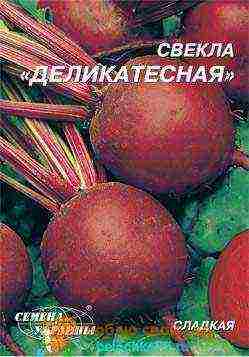 Delicacy variety
Delicacy variety
Delicacy beets are versatile and cold-resistant varieties. Fruits of the Delikatesnaya variety are used for cooking, preparing various dishes, preparations, and fresh consumption.
Maturation occurs on day 95. Small beets. The shape is round. The skin is smooth, thin. Beets are dark varieties and have dark cherry flesh. There are no radial rings.
With growth, several shoots begin to bloom, this practically does not affect the yield. The vegetable is stored for a long time. Versatile to use. The variety is suitable for central Russia, grows well in cool weather.
Opolskaya
 Beetroot Opolskaya
Beetroot Opolskaya
Mid-season, moisture-loving variety. The shape of the fruit is oblong. The skin is thin. The taste is slightly sweet. Thin rings are visible on the cut. At the beginning of growth, the variety is demanding for timely, abundant watering. Shelf life up to six months. The commercial quality and taste do not change during storage.
Incomparable А 463
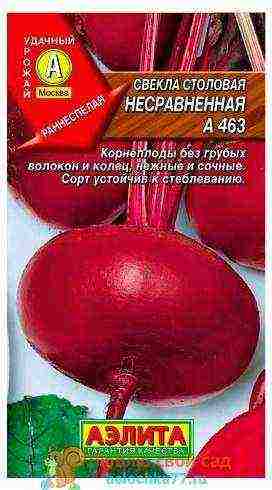 Grade Incomparable А 463
Grade Incomparable А 463
It is a high-yielding, unpretentious beet variety. The fruits are large, flat-round in shape. The top is red-gray. The pulp is dark cherry, tasty, juicy. A variety without light rings. Up to 9 kilograms of fruit can be removed from a square meter.
The crop easily tolerates wintering, does not lose its qualities. The growing season lasts 100 days. Beets of this variety are not damaged by pests or diseases.
Mulatto
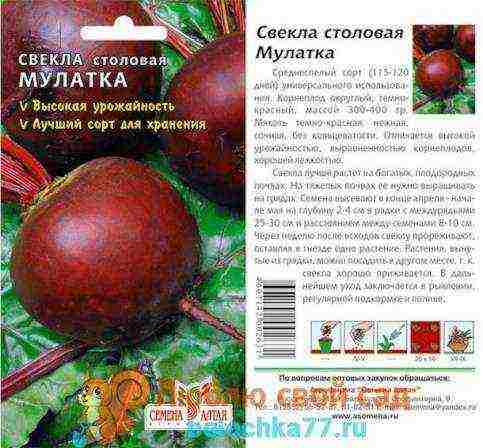 Variety Mulatka
Variety Mulatka
Differs in tasty and large fruits. Spherical beets. Weight reaches 500 grams. The pulp is uniform red, without light rings, soft, tasty. The color does not change during cooking. The harvest is stored throughout the winter.
Harvesting is done 115-120 days after sowing. Up to 7.5 kilograms of fruit are removed from one meter. Early plantings can be sold in bunches.
Cold resistant 19
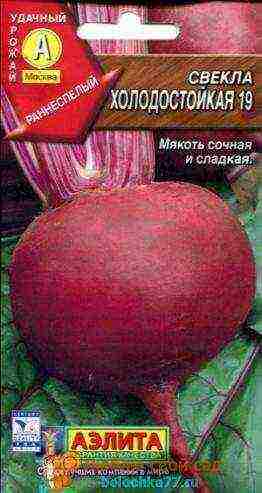 Cold-resistant grade 19
Cold-resistant grade 19
Cold hardy, medium early variety. The technical ripeness of root crops occurs in 65-76 days. The shape is flattened round. The color of the beets is dark red. The skin is smooth. Weight 150 - 230 grams. The pulp is very tasty, juicy, tender. The variety is suitable for bunch cultivation. The keeping quality of the fruit is good. You can sow in spring and before winter.
Noblewoman
 Variety Boyarynya
Variety Boyarynya
High-yielding and mid-season variety. The root crop is spherical. Weight 210-350 grams.With timely feeding, it increases.
Late varieties
These varieties have a long growing period. They are resistant to frost in spring and autumn and heat in summer. Vegetables are stored in a cool place until the next harvest. The loss of weight and appearance is negligible.
Renova
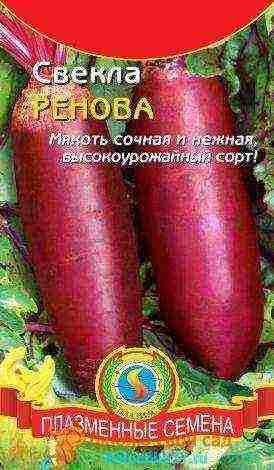 Renova variety
Renova variety
Renova beets are famous for their bountiful harvest. The shape is cylindrical. The skin is thin, dark pink. The pulp is reddish-purple. The fruit does not have a beetroot smell. The taste is pleasant. Fruit weight reaches 390 grams. The variety is cold-resistant and undemanding to the climate and growing conditions.
One-sprout
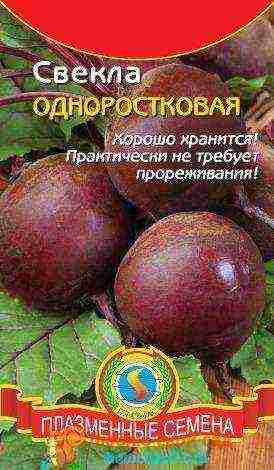 Single-sprout variety
Single-sprout variety
The single-sprout variety, with good care, allows you to remove up to a ton of root crops from a hundred square meters of land. From the moment of seed germination to full maturity of the fruit, 130 days pass. In a cool place, the vegetable is stored for up to six months. Average weight 450-550 grams.
The taste is pleasant, juicy. The pulp is dark burgundy. The skin is thin. The shape is flat-round. You can use cassettes for growing seedlings. The variety is not susceptible to disease.
Cylinder
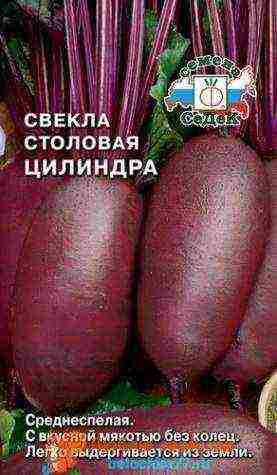 Cylindra grade
Cylindra grade
Cylinder red beet got its name from its cylindrical shape. The plant is cold and heat resistant. Ripens in 101-120 days. Up to 120 kilograms of fruit are collected from a hundred. The size of the roots is small. But with good care it reaches 700 grams. Length 25-32 centimeters.
The taste is pleasant, juicy, odorless. The color is bright, without light rings. The skin is thin. The harvested crop is stored for up to 9 months. Diseases, pests, frost and heat are not terrible for this variety.
Matron Zedek
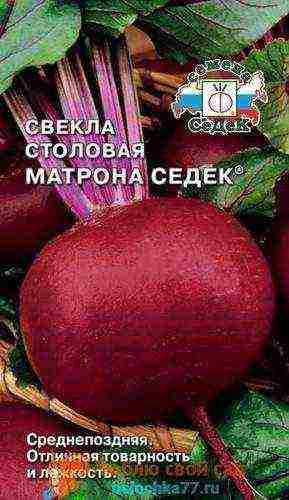 Matrona Sedek variety
Matrona Sedek variety
It is a late variety. Beets are dark varieties. Rings are weak. The shape of the fruit is flat-round. Weight reaches 300 grams. The taste is pronounced. The fruits are suitable for long-term storage, do not lose their qualities.
Citadella
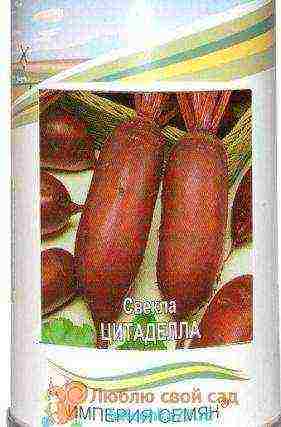 Citadella variety
Citadella variety
Red beet Citadela is a late-ripening variety. Average length. The shape is cylindrical. The pulp is bright, without light rings. The taste is beetroot. If stored properly, it lasts until May. The appearance and taste practically does not change.
You can also distinguish varieties: Belushi F1, Vinaigrette, Red Ruby, Bikores, Wodan F1, Two-seeded TSKHA, Bolivar, Crimson ball, Nohovski, Queen F1, Cold-resistant, Bettollo F1, Bona, Bordeaux single-seeded, Globus, Boro F1, Zhukovchanka, Libero, Subeto F1, Madam, Ideal, Demeter. They are distinguished by excellent taste and versatility in use.
Varieties for the Moscow region
For central Russia, you can choose quite a few varieties of beets, which, with proper care, give an excellent harvest of high-quality root crops.
Early varieties for the Moscow region include: Red ball, Wodan, Detroit, Pushkinskaya flat, Bordeaux-237, Boltardiran, Gribovskaya flat, Mulatka, Slavyanka. Beets of these varieties ripen in 2.5-3.5 months.
Red ball
 Variety Red ball
Variety Red ball
An early, dietetic variety. Sowing is done in early spring. Harvesting begins in 68-72 days. Root weight 150-250 grams. The pulp is very juicy, dark red. Cut rings are weak. 3-6 kilograms of root crops are removed from a square meter.
Wodan F1
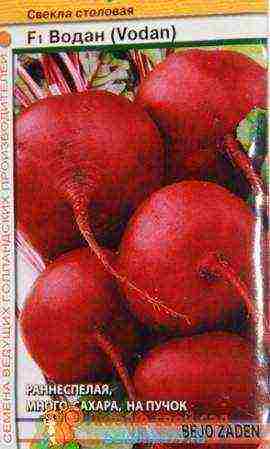 Variety Wodan F1
Variety Wodan F1
An early, high-yielding hybrid variety. The hybrid ripens in 78-82 days. The shape is round, smooth, the tail is thin. The color is dark red, without light rings. Root weight 220-500 grams. The taste is pronounced, juicy.
The best medium varieties: Eclipse, Bohemia, Egyptian flat, Donskaya flat, A-463, Bona, Cold-resistant-19, Matrona, Monocle, Patrick. Root crops are resistant to cold and drought. Stored well.
Eclipse variety
Mid-season. Beets have an elongated oval-cylindrical shape with a blunt, round or slightly curved shape. The pulp is red-violet, tender, juicy.
Late varieties include: Ataman, Podzimnyaya, Cylindra, Bordeaux single-seeded, Renova, Rocket, Bettina, Larka. The seeds of these varieties should be sown in late spring.
Variety Ataman
 Variety Ataman
Variety Ataman
Medium late, ideal for the Moscow region.Easily tolerates frost, does not like dampness. Maturation occurs at 120-130 days. The shape is cylindrical. Fruit weight 200-300 grams. The color of the root crop is dark red. The pulp is tender and juicy without light rings. The taste is excellent. The variety is lazy.
The pulp of these varieties is tender and juicy. The fruits are not intended for long-term storage.
Varieties for the Urals
For the Urals, the best varieties are: Bikores, Valenta, Bon-Bon F1, Odnorostkovaya, Bravo, Crimson ball, Betina, Detroit 2, Boltardi, Scarlett suprim, Gribovskaya flat A-473, Bordeaux single-seeded, Bordeaux 237, Bona, Mulatka, Virovskaya single-seeded , Crimson Globe, Incomparable A-463, Podzimnyaya A-474, Rougette F1, Dark red round, Chrobry (Brave), Cold-resistant 19, Cylinder.
Dark variety One-sprout - early maturing and fruitful. The vegetative period is 80-130 days. A distinctive feature of the variety is one and two-seeded fruits. The shape is rounded flat or round. Weight 300-600 grams. The color is rich, dark burgundy. The pulp is tasty, juicy and tender. Stored for a long time.
Bikores
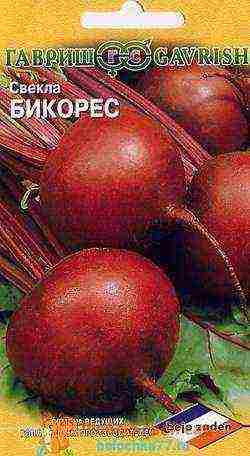 Variety Bikores
Variety Bikores
is a fruitful, mid-season beet variety. Sweet variety. The color of the fruit is maroon. The shape is round, leveled. Weight 210-350 grams. The pulp is bright, without light rings, tasty, juicy. About 6 kilograms of fruits are harvested from a square meter.
Valent's variety
 Valenta variety
Valenta variety
One-germ, grows in 95-100 days. Weight reaches 300 grams. The shape is oval-rounded. The pulp is sweet, tasty, dark red. The variety is dormant, cold-resistant, not afraid of diseases.
Bon-Bon F1
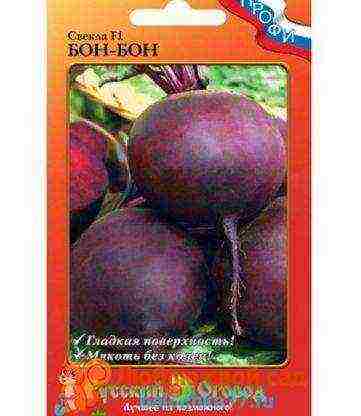 Variety Bon-Bon F1
Variety Bon-Bon F1
This is a medium-ripening beet variety. The growing season is 120 days. The flesh of the fruits is bright red, without light rings, tasty. The shape is round, with a thin skin. Sowing is carried out from April to mid-July.
These varieties easily tolerate sudden temperature changes and cool climates. With good care, the harvest is very abundant.
Harvesting is stretched until the end of September. For spring planting at the beginning of growth, it is recommended to use a covering material.
Varieties for Siberia
The most suitable varieties for the Siberian climate are: Siberian flat, Podzimnyaya, Red ice, Mashenka, Krasny bogatyr, Odnorostkovaya, Incomparable, Bordeaux 327, Cold-resistant, Pablo, Cylinder.
Siberian Flat Beet
An early variety, ripens in 98-100 days. The shape is flat. Beets are dark and reddish-purple in color. Weight 200-400 grams. The taste is excellent. The variety is cold-resistant, disease-resistant.
Winter
 Podzimnyaya variety
Podzimnyaya variety
Medium early grade. The shape is round. Weight 200-400 grams. The color of the pulp is burgundy. The variety is cold-resistant, resistant to most diseases.
Red ice grade
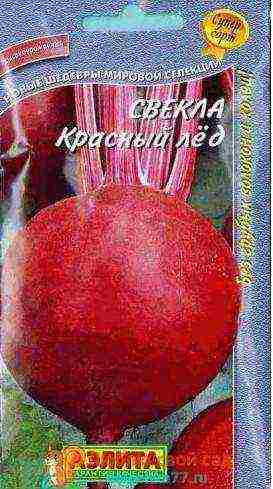 Red ice grade
Red ice grade
Ripens in 100 days. The pulp is bright, with small rings. The weight of root crops is 200–300 grams. 4-5.5 kilograms of beets are harvested from a square meter.
Red hero
High-yielding variety. The shape is cylindrical. The skin is thin, dark red. Pulp without rings. Weight 200-550 grams. Productivity from a square 8-10 kilograms.
Mashenka
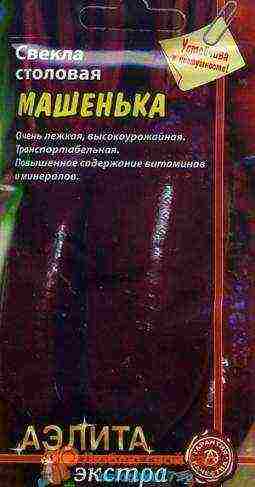 Variety Mashenka
Variety Mashenka
Mid-season and high-yielding variety. Dark red variety without light rings. The shape is cylindrical, smooth. Up to 9 kilograms of fruits are harvested from a meter. Fruit weight 310-600 grams. The fruits are delicious. The plant is not susceptible to disease.
Growing beetroot seedlings can increase the likelihood of a good harvest. The best option for planting is the cassette method. With this planting, 1 plant grows in a separate cell and planting and thinning is not required.
Under favorable conditions, an excellent harvest can be harvested by September - early October.
Quite often, in these regions, sowing is used before winter, when the ground is frozen, the seeds are placed in the beds, and in the spring, when the soil warms up, they quickly begin to grow.
Sweet varieties for central Russia, Moscow region, Siberia: a hybrid of Pablo, Detroit round, Incomparable, Cylinder.
Some of the most widely used and loved by gardeners varieties of the Urals and Siberia are: Red Ice, Bikores, Siberian flat, Mulatka, Krasny Bogatyr, Mondoro F1, Mashenka, Vital cylinder.
Dark varieties of beets are in great demand, suitable for preparing various snacks, juices, first and second courses, salads, and blanks.
All these varieties, with proper agrotechnical work, give an excellent yield of high-quality fruits.
Beetroot is one of the oldest vegetable crops that people grew 2 thousand years ago. Due to its unique ability to acclimatize and ease of maintenance, it can be cultivated in regions with warm and cold climates. More than 70 varieties of this vegetable are known to modern breeders and gardeners, which differ in external characteristics, ripening times and yield.
Choosing the best varieties of beets
Beets can range in color from raspberry to deep purple. It is believed that the most useful and tasty fruits are of intense color without pronounced light rings. It should be noted that such a statement can hardly be called a serious delusion, since a bright
beet color is due to the high concentration of anthocyanins - these are natural antioxidants, which also have antiseptic and vaso-strengthening properties.
Beets can be of different shapes, sizes and shades.
The color and taste of the fruit depend on several factors, but the characteristics of a particular variety play the main role in this case. So, what varieties of this extremely useful vegetable are considered the most useful, tasty, and most suitable for planting in a personal plot?
Early maturing varieties
|
One-sprout |
80-130 | 300-600 | Round or slightly flattened fruits of a bright maroon hue, tender and very juicy flesh | An early ripeness variety that usually begins the beet season. It gives a fairly large harvest, and has one valuable feature - the presence of only one sprout in the glomerulus, so that the planting does not have to be thinned out |
|
Improved Red Orb |
72-78 | 150-250 | As the name implies, the fruits of the Red Ball are aligned and round, the flesh tastes very delicate, and has excellent tasting characteristics. | The fruits contain many beneficial substances and are often used for medicinal purposes. Other advantages include the simultaneous ripening of the crop and excellent preservation of root crops in the cold season. |
|
Winter |
55 | 200-300 | Rounded, juicy roots of intense dark red color. There are no cross rings on the cut | The variety is especially recommended for winter planting. Under favorable conditions and proper care, the yield of "Podzimney" can be significantly higher than that of other early-maturing varieties. In addition, such an unpleasant phenomenon as flowering is not typical for her. |
|
Boltardi |
100-110 | 150-350 | Smooth, medium-sized fruits that have a smooth skin and a uniform dark cherry flesh without ringing (sometimes, ringiness may be mild) | Due to its excellent commercial characteristics, this variety is especially common in small farms that grow vegetables for sale. Has good plasticity, resistance to the appearance of arrows. Root vegetables are versatile, meaning they can be eaten fresh, canned or stored |
|
Egyptian flat |
110-130 | 300-500 | Small oval, slightly flattened fruits with a uniform, reddish-purple surface color. The pulp with a slight shade of pink has no transverse ringiness, and is distinguished by tenderness, juiciness and good taste. | Plantings of this variety give a large yield, are not subject to flowering. The fruits are well suited for consumption in the autumn-winter period, as they can be stored for a long time. |
|
Libero |
80 | 125-225 | The fruits have a very attractive appearance: round, smooth and aligned, with a thin root, colored inside and outside in a bright dark red color.The pulp is firm, with little or no ringing | The variety is moderately resistant to the appearance of arrows, gives a large yield, but when growing it should be remembered that it is quite picky about soil moisture |
Mid-season varieties
|
Bohemia |
70-80 | 300-500 | Fruits are round or slightly flattened in shape. Inside, juicy, tender maroon pulp, without transverse rings, with a pleasant, sweetish taste | The variety belongs to those that are especially recommended for cultivation in gardens and summer cottages. It is unpretentious in care, does not require thinning, is not prone to flowering and diseases characteristic of beets, and besides, it is very well stored in winter. It is recommended to grow "Bohemia" on fertile soils with neutral acidity - in this case, it gives a particularly rich harvest |
|
Bordeaux |
62-116 | 230-510 | Rounded or slightly flattened with intense coloration and firm, tender, dark red sugary flesh | One of the most widespread varieties of beet, which has been cultivated in Russia for over a century. The main advantage is that it can grow and yield good yields in almost any conditions. The pulp is distinguished by a high concentration of sugars and anthocyanins, due to which the beets of this variety are considered almost the most useful. Stores well in winter and is suitable for all types of processing. Plants are unpretentious to care for, and their fruits are immersed in the ground by about half, that is, harvesting is greatly simplified |
|
Detroit |
100-110 | up to 250 | Smooth, round, uniform size fruits with a smooth surface and a small rosette of leaves. The color of the flesh is red, rich, without transverse rings on the cut | The main advantages include high yield, resistance to shooting, unpretentiousness to growing conditions and excellent keeping quality during storage. |
|
Larka |
100-120 | 150-300 | Small round fruits with a neat rosette of leaves and an intense dark red surface. The pulp does not have transverse cut rings (in some cases they are poorly expressed) and has an excellent taste | A variety, bred in Holland, which is highly resistant to the emergence of flowers and many diseases. Suitable for harvesting using agricultural machinery, well suited for fresh consumption, and for processing and storage. Separately, it should be noted that the use of this variety of beets promotes the removal of radionuclides from the human body. |
|
Bona |
120 | 250-280 | Beautiful, rounded fruits of deep red color with a soft head, the surface is smooth. They taste juicy, tender, without ringiness on the cuts, with excellent tasting qualities. | Beetroot varieties "Bona" are ideal for use in cooking (both fresh and processed) and canning. The variety is highly valued among farmers and gardeners for its high yield and good keeping quality. |
|
Mulatto |
120-130 | up to 350 | Root crops are round, even, with a smooth skin closer to maroon color. The rosette of leaves is small, standing, the pulp is of a bright color that does not fade even during cooking | One of the recently bred varieties, which is easy to care for and gives a good harvest. In winter it is stored without loss of flavor characteristics |
|
Incomparable А463 |
69-100 | 170-390 | Rounded or flattened fruits, the surface is dark red, slightly burgundy, slightly grayish at the head. | A kind of "Bordeaux" variety, which many gardeners call the best in taste of all domestic. In addition, it is the leader in the content of a beneficial substance called betaine. The variety is relatively resistant to most diseases, but its keeping quality is average - over time, the fruits begin to deteriorate |
|
Pablo F1 |
78 | 109-180 | Rounded, attractive-looking, thin-skinned fruits with intense red flesh without transverse ringing | Extremely hardy, frost-resistant, not prone to flowering variety, which is recommended for cultivation in unfavorable climatic conditions. Practically unaffected by diseases and pests |
Why beets sometimes go into bloom
Late-ripening varieties
|
Cylinder |
110-130 | 180-350 | Fruits have an oblong shape, unusual for beets, length - 10-16 cm. The pulp is very juicy, sugary, with an increased concentration of iron, calcium and vitamins does not have a characteristic "beet" flavor | The variety is resistant to most diseases, and it is very easy to harvest such beets, as they grow above the soil surface. "Cylinder" is widely used in cooking, not only because of its taste, but also because its fruits are cooked very quickly. The variety is also well suited for storage - in a cool place, beets can survive the winter without loss. |
|
Renova |
100-110 | 180-350 | Smooth, dark pink cylindrical fruits. The pulp tastes very juicy, dense and tender, without pronounced ringiness | The variety gives a high yield of fruits with excellent keeping quality (they can be stored for at least six months without losing taste) |
How to grow delicious beets?
It should be noted that the color and taste of root crops depends not only on the variety, but also on the conditions of "life" and planting care. In order for the roots to be tasty and have a bright, beautiful color, the gardener needs to remember several important rules.
- At elevated temperatures or after prolonged drought, the intensity of the color of the fruit decreases, and white fibrous rings appear on the cuts. In addition, the beet pulp becomes rough and tasteless.
- Excess moisture is no less harmful to plantings than its prolonged absence. In this case, the root vegetables become excessively large, acquire a watery taste, and voids form inside, which makes the beets unsuitable for storage.
Recommendations for watering beets
- Beets should not be planted immediately after applying organic fertilizers to the soil, otherwise the fruits will taste bitter.
- Do not shade the plantings too much, as this reduces the content of sugar and dry matter in the pulp, on which the taste of beets depends.
Why beets are bitter and how to prevent it
With proper and timely care, any variety of beets will provide the gardener and his family with healthy roots, from which many delicious dishes can be prepared.
Video - How to grow beets healthy and tasty
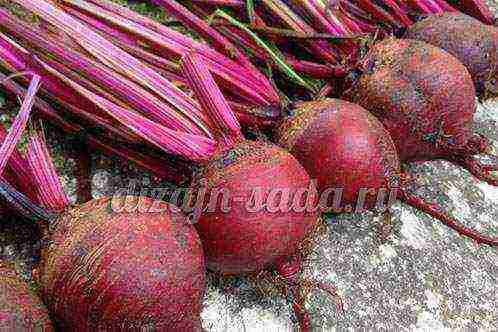
According to the ripening period, beets are divided into early, mid-ripening and late. For winter storage, the second and third are suitable. Early and ultra-early beets are good because they ripen in 2-3 months, but they do not lie well.
Using personal experience, reviews of gardeners from the forum and neighbors in the country, I will describe the best yielding varieties of beets.
The best early varieties of beets, descriptions, reviews
Egyptian flat beet
Early maturing (from germination to harvesting 95-115 days) beet variety. Root crops are flat-round, dark red, weighing 200-400 g. The flesh is red with a purple tint, juicy, good taste.
Advantages of the variety: stable yield, resistance to drought and flowering, suitability for long-term storage.
Egyptian flat sekla is suitable for all types of culinary processing.
Beet yield Egyptian flat: 5 - 8.3 kg per sq.m.
Beetroot Red ball improved
Ultra-early (72-78 days from germination to harvest) high-yield beet variety. Root crops are even, rounded, weighing 150-250 g. Their flesh is dark red, tender, juicy, sweet, almost without rings, quickly cooked.
Advantages of the variety: amicable yield of the harvest, high commercial qualities, good keeping quality. Recommended for home cooking, as well as for baby and diet food.
Beet yield red ball: 3 - 6 kg from 1 sq.m.
Bordeaux beet 237
Medium early variety (period from full germination to technical ripeness 95-110 days). Root crops are round, weighing 200-500 g, with dark red pulp and excellent taste.
Advantages of the variety: comparative heat resistance, high yield in all weather conditions, good keeping quality during winter storage. Recommended for cooking and processing. Due to the rapid overgrowth of root crops, later and thickened crops are recommended.
Beet yield Bordeaux 237: 4 - 8 kg from 1 sq.m.
Cold-resistant beets 19
A mid-early variety of beets, the period from full sprouting to technical ripeness is 66-76 days. Root crops are flat-rounded, dark red, smooth, weighing 150-220 g. The pulp is juicy, tender, with excellent taste.
The variety is suitable for growing on a bunch with podwinter and early spring sowing. Used fresh, for processing and long-term storage.
Advantages of the variety: cold resistance, suitability for winter sowing, resistance to flowering, good keeping quality.
Beet yield Cold-resistant 19: 4-7 kg from 1 sq.m.
Mid-season beet varieties, description, photo
Beetroot bohemia
A mid-season variety (70-80 days pass from the moment of germination to ripening) of table beet. Root crops are rounded and flat-rounded, with a maroon color. The pulp is maroon, juicy and tender, without rings, with excellent taste. The weight of one fruit is 300-500 g.
Advantages of the Bohemian variety: resistance to cercosporosis and flowering, does not require thinning, good keeping quality.
Beet yield Bohemia - up to 4.8 kg from 1 sq.m.
Bona beet
High-yielding mid-season beet variety (period from germination to harvesting 115-120 days). Root crops are rounded, large, aligned, smooth, dark red. The pulp is evenly colored, without rings, has excellent taste.
Advantages of the variety: large root crops have high commercial qualities and good keeping quality.
Beet yield of Bona: 5.5 - 6.8 kg per sq.m.
Detroit beet
The most common mid-season beet variety (100-110 days pass from germination to ripening). Root crops of the correct, rounded shape, the same size, with a smooth skin, deep red color, without rings. The weight of the roots is about 250 g. The rosette of leaves is not dense.
Advantages of the variety: resistance to shooting, high yield, even fruits with good marketable qualities, excellent keeping quality. Suitable for both long-term storage and processing.
Beet yield Detroit: 3.6 - 6.9 kg per sq. m.
Beet Incomparable A 463
Medium-early high-yielding, cold-resistant beet variety, 70-100 days pass from germination to harvest. Root crops are rounded and flat-rounded, weighing 170-400 g, dark red with a burgundy tint.
Advantages of the variety: cold-resistant, resistant to flowering and cercosporosis. Possesses good keeping quality.
Beet yield Incomparable А 463: 2.9 - 7.0 kg from 1 sq.m.
Agricultural technology: sowing May 1-15, sowing pattern 30 x 7 cm, harvesting July 25 - September 5.
Beet mulatto
New mid-season variety (from germination to harvesting 120-130 days).
Root crops are rounded, leveled, smooth, maroon color, weighing 150-350 g. The pulp is red, without rings, juicy, tender, with excellent taste. Preserves color when heat treated. Ideal for winter storage.
Sowing with seeds in the ground in late April - early May to a depth of 2-4 cm, with row spacing of 25-30 cm and a distance between seeds of 7-8 cm.
Beet yield Mulatto: 2.5-4.4 kg from 1 sq.m.
The best late varieties of beets, description, photo
Renova beet
Late-ripening, high-yielding variety with long cylindrical dark pink roots. From mass germination to technical ripeness, 100-110 days pass.
Root crops are leveled, weighing 180-350 g, with dark purple juicy, tender, dense pulp, without rings.
Advantages of the variety: good keeping quality for 6-7 months, while not losing taste.
Renova beet yield: 7-9 kg from 1 sq.m.
Beet Cylinder
Medium late (120-130 days) beet variety. Root crops are cylindrical, 5-9 cm in diameter and 10-16 cm long, weighing 180-250 g, with a thin skin. The pulp is juicy, sweet, dark red, without rings.
The Cylinder variety is distinguished by good keeping quality and resistance to the main diseases of beet. Possesses excellent taste.
Cylinder beet yield: 7-10 kg from 1 sq.m.
Beets prefer fertile sandy loam soils. Seeds are sown in the ground in the second half of May. The seeding depth is 2-4 cm, the distance between the rows is 30 cm, between the seeds is 7-8 cm.
Beets are responsive to potash and ash fertilization. During the entire growing season, loosening of row spacings, weeding, thinning of seedlings is carried out. Beets are watered depending on weather conditions; they do not tolerate waterlogging.
For winter sowing, seeds are sown at the end of October to a depth of 4-6 cm.
The best precursors for beets are early potatoes, onions, cucumber, pumpkin, and squash.
We recommend purchasing beet seeds of excellent quality in the Sady Rossii online store.
Sugar beet varieties and hybrids differ in many ways. But among them there are absolute leaders, bred as a result of many years of selection. Now you will learn about nine of the best beet varieties based on a combination of traits.
First of all, table beets should be tasty, safe for health and have a long shelf life. Many gardeners believe that the whole set of these qualities can only be found in varieties of foreign selection. Indeed - imported root crops are smooth and beautiful, consistently pleasing with a high yield. But even among the domestic varieties, you can find sweet and spicy varieties. We will tell you about the best of the best representatives of the beetroot world.
Bordeaux 237
This variety was bred by Soviet breeders in 1943. This is one of the most popular and studied mid-season varieties. The plant is thermophilic and demanding on lighting, but at the same time it is distinguished by drought resistance. Root crops are round and flat-rounded, with delicate flesh of a thick burgundy color. The sugar content is high, while the beets are stored for a long time without losing their taste. The variety is resistant to diseases, occasionally affected by cercosporosis and peronosporosis.
| Appointment | Root diameter (cm) | Beet weight (g) | The period from germination to technical ripeness (days) |
Yield (kg / sq.m) |
|
|
12-15 |
260-500 |
60-110 |
4-8 |
||
Bravo
One of the most productive, unpretentious, tasty and mature varieties. It can be grown all over the area from Moldova to the Ural Mountains. Root crops are round, smooth, dark red, with a small head. The pulp is light burgundy, without ringiness, dense and juicy. Up to 98% of the sown seeds emerge. A plant below average is affected by cercospora and beet flea.
| Appointment | Root diameter (cm) | Beet weight (g) | The period from germination to technical ripeness (days) |
Yield (kg / sq.m) |
|
|
13-16 |
250-680 |
70-100 |
3-7 |
||
Valenta
Mid-season high-yielding variety. The roots are dark red, smooth and clean. The pulp is juicy and tender, with faint rings. A ripe root crop is easily pulled out of the soil. The taste is memorable, dessert. Beets contain a large amount of B and PP vitamins. The plant withstands extreme cold, but responds to lower temperatures by lowering yields. The harvested crop can be stored for a long time without fear of loss of presentation.
| Appointment | Root diameter (cm) | Beet weight (g) | The period from germination to technical ripeness (days) |
Yield (kg / sq.m) |
|
|
12-15 |
175-330 |
90-120 |
4-8 |
||
Mona
Medium early single-sprout variety. Root crops are cylindrical, red in color with a dark color. The pulp is dark red, juicy and melts in the mouth. The plant does not need additional thinning during the growing period. Water the roots as needed, slightly increasing the frequency of watering during dry periods.Regular feeding and loosening should be carried out and then the plant will not be afraid of diseases.
| Appointment | Root diameter (cm) | Beet weight (g) | The period from germination to technical ripeness (days) |
Yield (kg / sq.m) |
|
|
10-13 |
200-330 |
75-100 |
5,5-7 |
||
Mulatto
Outwardly, this variety does not differ much from the usual table varieties of beets. Root crops are of the correct round shape, as they ripen, they change color to maroon. Gardeners appreciate the pulp for its amazing taste and the absence of rings. The yield of the variety is quite high and practically does not require additional care. Mulatto is best stored during the winter months, and the marketable yield is usually 95-98%.
| Appointment | Root diameter (cm) | Beet weight (g) | The period from germination to technical ripeness (days) |
Yield (kg / sq.m) |
|
|
10-12 |
180-360 |
125-130 |
3,5-6 |
||
Incomparable А463
It is a rare case when the properties of a product fully correspond to its name - this is really one of the best varieties. Root crops are usually flat, sometimes round-flat with a maroon skin, which turns gray closer to the outlet. Beets have a delicate flesh with a dark scarlet hue and dark rings. The variety is absolutely resistant to cercosporosis and keeps well for several months. Great for all types of home cooking.
| Appointment | Root diameter (cm) | Beet weight (g) | The period from germination to technical ripeness (days) |
Yield (kg / sq.m) |
|
|
8-10 |
170-360 |
70-100 |
3-6 |
||
Pablo F1
This hybrid was obtained relatively recently, but has already managed to fall in love with many gardeners for its useful properties and unpretentiousness. Medium early in terms of ripening, it has an unsurpassed yield, which reaches 98-99%. All root vegetables are like siblings - they are very similar to each other, with thin skin and a small tail. The flesh on the cut is bright red, without annular divisions. Plants thrive in cold regions and can be stored throughout the winter.
| Appointment | Root diameter (cm) | Beet weight (g) | The period from germination to technical ripeness (days) |
Yield (kg / sq.m) |
|
|
10-15 |
125-450 |
60-100 |
6-7 |
||
Rocket F1
The elongated roots of this hybrid are difficult to confuse with others. It belongs to the mid-season and is used both for processing and for haute cuisine. Root crops are cylindrical, dark red, with a smooth, almost glossy surface. The color is intense and uniform. The color of the flesh approaches purple, the rings are absent. The taste is excellent. The yield and keeping quality of root crops is high.
| Appointment | Root diameter (cm) | Beet weight (g) | The period from germination to technical ripeness (days) |
Yield (kg / sq.m) |
|
|
3-5 |
250-400 |
120-125 |
5-7 |
||
Cylinder
The unusual shape of the root crop, characteristic of this variety, attracts gardeners very much. These are medium-sized plants with dark red oblong fruits and a small "waist". The variety is weakly susceptible to various kinds of diseases, therefore, yields are high. The sweet taste allows you to add beets to borsch, salads and use for preservation. There are no whitish circles in the root crop, so it is very convenient to cut the beets and add them to various dishes.
| Appointment | Root diameter (cm) | Beet weight (g) | The period from germination to technical ripeness (days) |
Yield (kg / sq.m) |
|
|
4-5 |
250-500 |
110-130 |
5-7 |
||
Sweet beets are a real decoration for any table. With her, dishes acquire a completely new taste and emphasize the skill of the chef. Anyone can grow such beets, especially if you grow one of the varieties we have described.


